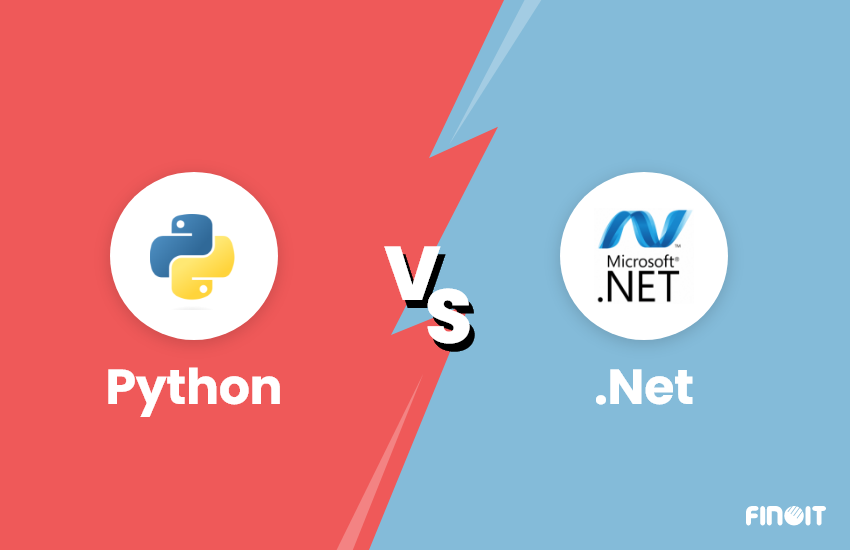Python vs. .Net: Choosing the Right Language For Your Project

You have an idea for web development and think about which language is best for your project. Among the choices available, you are considering Python and .NET, thus making you draw Python vs. .Net comparison.
You’ve probably heard these names, but you’re curious how each of them can contribute to your project’s success. Both Python and .NET are potent tools for application development. They’re not just popular but also user-friendly and efficient.
As a result, you need to think of Python and .NET as dynamic duo languages. They both follow a smart approach called Object-Oriented Programming (OOP), which means they’re great for beginners and experienced programmers. They’re like the turbo boosters of coding, helping you create things quickly and smoothly.
But that’s not all, these languages aren’t just trendy; they’re major players in the programming world. Now, we’re going to figure out which one of these superheroes—Python or. NET—fits perfectly as the sidekick for your business app.
Let’s get started to dive deep into the nitty-gritty of Python vs Net.
Python vs .NET: Making the comparison to select the best for your project
Deciding between Python and .NET for your projects can become challenging, as each of them brings commendable capabilities. This comprehensive analysis thus compares the two programming languages across multiple parameters to let you make the right selection decision.
Focus
Python
When choosing the right programming platform for your next project, understanding the distinct application focuses of Python and .NET is crucial. Both languages have their strengths and specialties, catering to different domains within the vast software development landscape.
Python, renowned for its versatility, finds its prowess in various applications. It has made a significant mark in web development, offering frameworks such as Django and Flask, two of the top python frameworks that empower developers to create robust and efficient web applications. Additionally, Python shines as a go-to choice for data analysis, where its rich libraries like Pandas and NumPy streamline the process of extracting insights from data.
Also read: Why choose python for your software project?
The field of machine learning also beckons Python’s capabilities, with libraries such as TensorFlow and scikit-learn providing the tools for creating intelligent and predictive models. Moreover, Python’s scripting abilities make it an excellent choice for automation tasks, simplifying repetitive processes and enhancing productivity.
.NET
On the other hand, .NET, with the formidable backing of Microsoft, boasts a distinct application focus. It stands out as a robust platform for crafting Windows applications that cater to diverse user needs. The .NET framework empowers developers to build feature-rich desktop applications seamlessly integrating with the Windows ecosystem.
Beyond this, .NET extends its prowess to web development, providing a comprehensive framework known as ASP.NET for creating scalable and dynamic web applications. .NET’s strength further extends to the domain of enterprise solutions, where it excels in crafting powerful and efficient applications that cater to the complex needs of businesses. One of its primary languages, C#, plays a pivotal role in this landscape, offering a versatile toolset for creating a wide range of applications.
Speed
Python:
Python is like a sprinter regarding development speed. Its simple and concise syntax allows developers to express ideas quickly and write code with fewer lines. This makes Python an excellent choice for projects that need rapid prototyping and frequent iterations.
With Python, you can swiftly bring your concepts to life and test them out, which is particularly beneficial in fields like data analysis, web development, and even building AI models. Its rich collection of libraries and frameworks further speeds up the process. Python’s flexibility enables developers to experiment and pivot without getting bogged down in intricate details.
.NET:
On the .NET side of the track, things seem more deliberate at first. .NET languages like C# and VB.NET emphasizes static typing and can appear more verbose. This initial trade-off might slow the initial development phase, as you must be more explicit about types and code structure.
However, this meticulous approach pays dividends in the long run,whatever the project size. The well-structured framework provided by .NET helps maintain consistent architecture and coding practices, leading to faster development and fewer issues. It’s like building a solid foundation before constructing a skyscraper.
Performance
Python
It is a dynamic and interpreted language. This means that when your Python code runs, an interpreter converts your human-readable code into machine-readable instructions on-the-fly. This dynamic nature introduces some overhead, leading to slightly lower performance than languages like Java or C#. However, Python has traditionally emphasized ease of use and development speed rather than raw execution speed. The good news is that Python’s performance limitations might be insignificant in many applications.
To boost performance in Python, developers can turn to libraries like NumPy and Cython. NumPy is a powerful numerical computing library that’s optimized for performance. It can efficiently handle large arrays and matrices, crucial for scientific and data-intensive tasks. Cython, on the other hand, lets you write Python-like code that’s compiled into C code, offering a substantial performance boost for specific use cases.
.NET
.NET’s performance story is a bit different. Being a compiled language, .NET languages like C# are transformed into machine code before execution. This compilation step eliminates the need for on-the-fly interpretation, resulting in better overall performance. This aspect makes .NET an excellent choice for applications that require high performance, such as complex calculations, simulations, and games.
Support
Python
Its community is like a bustling idea, collaboration, and innovation marketplace. It’s known for its inclusivity and welcoming nature, making it a fantastic environment for developers of all skill levels. This vibrant community has given birth to abundant resources, libraries, frameworks, and tools that cater to almost every programming need imaginable. Whether diving into data science, web development, or artificial intelligence, you’ll find a supportive community eager to share knowledge and provide solutions.
Python’s documentation is renowned for its clarity and comprehensive coverage. Whether you’re a beginner or a seasoned developer, Python’s official documentation, along with countless online tutorials and forums, ensures you have access to answers whenever needed.
.NET
Backed by the tech giant Microsoft, it enjoys robust support and a dynamic ecosystem. This backing provides a sense of reliability and stability to developers. The company’s commitment to .NET is reflected in regular updates, security patches, and the continuous evolution of the framework. This consistency ensures that your .NET applications stay up-to-date and secure.
Microsoft’s involvement also means that .NET has many resources available. From official documentation to tutorials, forums, and libraries, you’ll find an array of support mechanisms. This support extends to various aspects, including web development, desktop applications, cloud computing, and more.
Future Outlook
Python
It has been remarkable, from a beginner-friendly language to an essential tool in cutting-edge fields like artificial intelligence (AI), machine learning, and automation. Its simplicity, versatility, and extensive libraries have propelled it to the forefront of these domains. As machine learning and AI continue to permeate industries, Python’s popularity shows no signs of waning. The language’s expressive syntax and accessibility make it an ideal choice for developers who want to dive into AI without battling complex code structures.
Furthermore, the coming of the Internet of Things (IoT) has boosted Python’s prospects even more. Its compatibility with hardware programming tasks aligns well with the demands of IoT devices, solidifying its position as a versatile language for the future.
.NET
With the introduction of .NET 5 and subsequent versions, Microsoft has reinforced its commitment to the framework’s continuous improvement and cross-platform capabilities. The merging of .NET Core and .NET Framework into a unified .NET platform represents a strategic move towards modernization and improved performance.
.NET’s relevance in Windows app development remains strong, and its cross-platform capabilities have opened new doors for developers seeking to create applications that can run seamlessly on multiple operating systems. As cloud computing and containerization gain momentum, .NET’s compatibility and support for these technologies keep it aligned with the contemporary software landscape.
Platform Flexibility
Python
Versatility shines through its cross-platform compatibility, allowing it to operate across diverse systems with minimal tweaking smoothly. This feature serves as a time and effort saver, ensuring that your Python-based applications can seamlessly run on various platforms, whether it’s Windows, macOS, or Linux. The adaptability of Python eliminates the need for extensive modifications, making it an appealing choice for developers seeking efficiency in the realm of platform portability.
.NET
A dynamic scenario unfolds with the advent of .NET Core. This iteration of .NET empowers developers to craft applications that transcend platform boundaries. This cross-platform prowess broadens the spectrum of deployment possibilities, granting the flexibility to operate on Windows, macOS, and Linux environments. However, it’s vital to note that the traditional .NET framework leans more toward the Windows domain.
So, Python or .NET, which to choose?
Choosing between Python and .NET hinges on their respective strengths and limitations, tailored to the unique requirements of your project. Delving into your project’s purpose, speed benchmarks, and scalability prerequisites will steer you toward the optimal choice.
Python proves its prowess in crafting web applications and conquering domains like machine learning, data analysis, and scientific computing. Its gentle learning curve and various libraries and resources catalyze the development journey.
Conversely, if your sights are set on a Windows-centric application or a grand-scale venture necessitating robustness and scalability, .NET emerges as the frontrunner. It’s engineered for enterprise-level applications and benefits from a sprawling library that simplifies development.
When making this pivotal decision, remember that Finoit Technologies, a trusted software development agency specialists, are here to guide you. As a reputable company, we offer expertise in both Python and .NET, ensuring that your journey aligns seamlessly with your aspirations. Connect with our development experts to discuss further.

